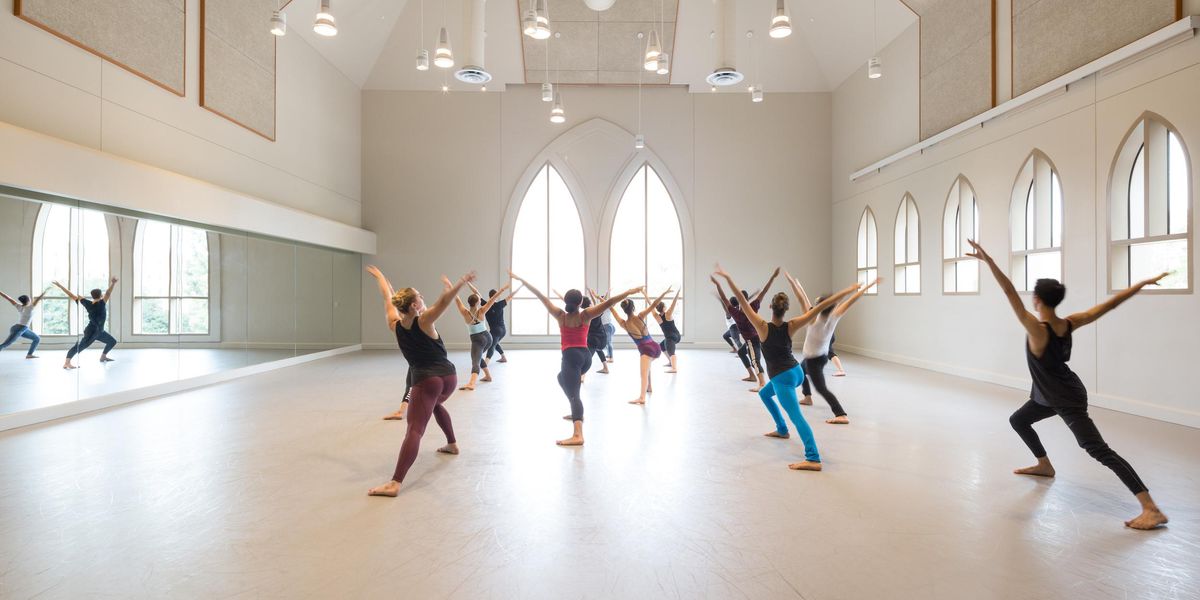Vital Signs
A Genius Encounter
The new revival of Einstein on the Beach, the trippy five-hour opus by Robert Wilson and Philip Glass, with choreography by Lucinda Childs, makes its official North American premiere this month at Toronto’s Luminato Festival. Twenty years since its last revival, the premise remains the same—the audience is invited to enter and exit at will, testing the stamina of both performer and viewer. Joining Einstein—which was presented in London as part of the Cultural Olympiad (see “Dance Matters”) and will tour to BAM and Berkeley’s Zellerbach Hall in the fall—is Sadeh21, Ohad Naharin’s newest piece for his Batsheva dancers and a Luminato co-commission. June 8–17. www.luminato.com.
Helga Davis and Kate Moran in
Einstein on the Beach. Photo by © Lucie Jansch, Courtesy EOB.
Rhythm & Soul
Brooklyn’s DanceAfrica festival, the annual feast of sights and sounds that takes over the Brooklyn Academy of Music Memorial Day weekend, celebrates its 35th anniversary this year. A special performance on May 20 welcomes back the artists who appeared at the first DanceAfrica in 1977. Ammamre Mma Dance Theatre from Ghana will perform at both DanceAfrica and DanceAfrica DC the following weekend. The DC counterpart at Dance Place, which began 10 years after the Brooklyn original and will host master classes the week leading up to the performances on June 2–3, will honor founder Chuck Davis, who received a Dance Magazine Award in 2004. www.bam.org and www.danceplace.org.
Chuck Davis at DanceAfrica 2011. Photo by Julieta Cervantes, Courtesy BAM.
First Light
Gustavo Ramírez Sansano, director of Luna Negra Dance Theater and a 2012 “25 to Watch,” is brimming with ideas. His latest, “Luna Nueva,” in partnership with the Museum of Contemporary Art Chicago, aims to have Latino choreoraphers set multidisclipinary work on the company. For this first installment, Diana Szeinblum of Argentina, a dance-theater choreographer who worked with Pina Bausch, and Luna Negra dancer Mónica Cervantes will premiere pieces, while Sansano imports his frenzied En busca de, made for Barcelona’s IT Dansa. June 7–10. www.lunanegra.org.
Mónica Cervantes. Photo by Jonathan Mackoff, Courtesy Luna Negra.
This House Is Not a Home
Joe Goode’s signature blend of wit, spoken word and song, and high-voltage movement has resulted in a deeply personal body of work. For Joe Goode Performance Group’s latest, When We Fall Apart, the choreographer teamed up with architect Cass Calder Smith to explore the concept of home. Goode will question the “myth of stability” (in his words) that home can evoke, its connotations of the traditional family, and how it relates to the body. The choreographer invited his audience to submit their own stories about some of these issues in his yearlong “Human Kind” series of work-in-progress showings. This culminating performance, a Z Space commission, will show what he has done with those stories. June 14–30. www.joegoode.org.
Jessica Swanson, with Felipe Barrueto-Cabello and Alexander Zendzian. Photo by RJ Muna, Courtesy JGPG.
Where It Rains and Shines
Despite the city’s famously gloomy weather, the jam-packed schedule of this year’s Seattle International Dance Festival is enough to sway even the most seasonally affected. The festival offers five different programs, including “Art-on-the-Fly,” which takes audiences around South Lake Union via a streetcar, finishing grandly with live music and dancing in Lake Union Park. The “Inter/National Series” of performances runs the global gamut, while “Spotlight on Seattle” places programming in the hands of three curators—Olivier Wevers, Tonya Lockyer, and Dan Mayer. But perhaps the most capricious component will be the most exciting: The new cabaret-style “Sanity Café,” which compels choreographers to band together and create a piece based on an audience-chosen theme in just one week. www.phffft.org/sidf.html.
Meredith Sallee on the docks of Lake Union Park for “Art-on-the-Fly” 2011. Photo by Courtesy SIDF.
Love Byrd
Love: You can’t live with it and you can’t live without it. But you can most certainly dance about it—and Spectrum Dance Theater will do just that with their season finale, Love. In keeping with the company’s season-long theme “love: subject/object,” director Donald Byrd seeks to answer his self-imposed question of whether his current view of love is as dark as it has been in the past. Considering Byrd’s customary hard edge, it’s bound to be a bumpy ride. www.spectrumdance.org.
Kate Monthy and Donald Jones Jr. in the season opener,
The Beast. Photo by Gabriel Bienczycki, Courtesy SDT.
Moving Into Politics
What did Martha Graham write to the Third Reich when she famously refused to participate in the Berlin Summer Olympics in 1936? How did our government hope that Alvin Ailey American Dance Theater would alleviate tensions abroad during the Cold War? Which choreographer was placed under surveillance by the FBI for her communist leanings? The Library of Congress answers these questions and more with photos and artifacts in “Politics and the Dancing Body,” running through July 28. The exhibit documents the numerous 20th-century choreographers and dancers who made political art in response to World War II, the Cold War, and societal issues at home—including Yuriko, who was forced to live in a “War Relocation Camp” after the bombing of Pearl Harbor (her Shut Not Your Doors, 1946, is pictured at right). If you can’t make it to DC (or L.A., where “Politics” will be on view from Aug. 25–Feb. 16), see it online at www.myloc.gov/exhibitions/politics-and-dance.
Photo from Victoria Phillips Collection, Music Division, Library of Congress, Courtesy Yuriko and Susan Kikuchi.
Contributing writers: Kina Poon, Rachel Rizzuto




